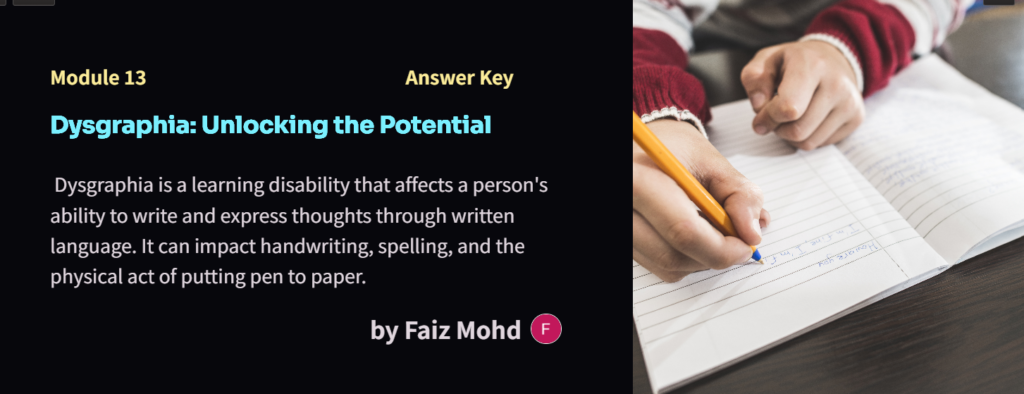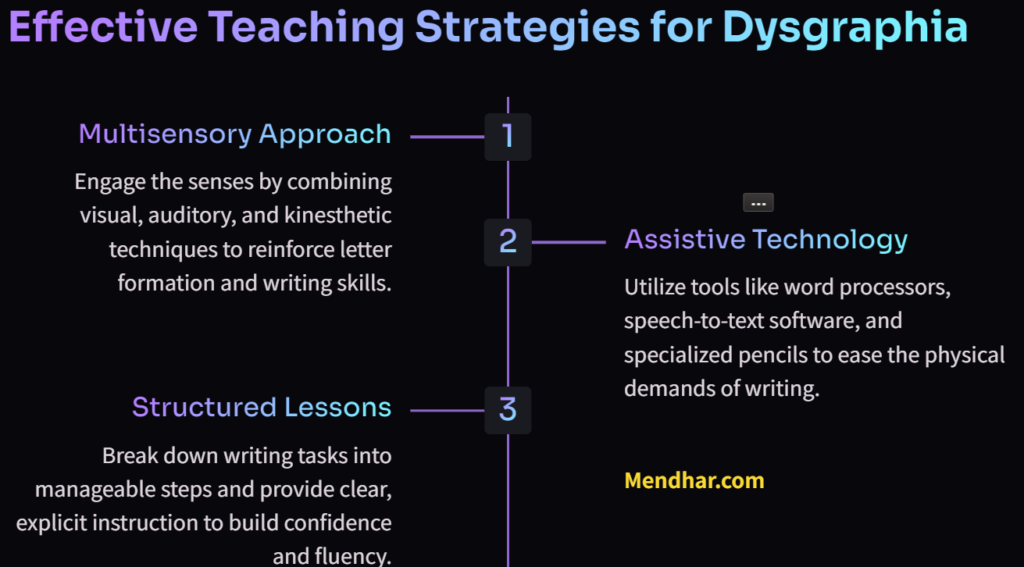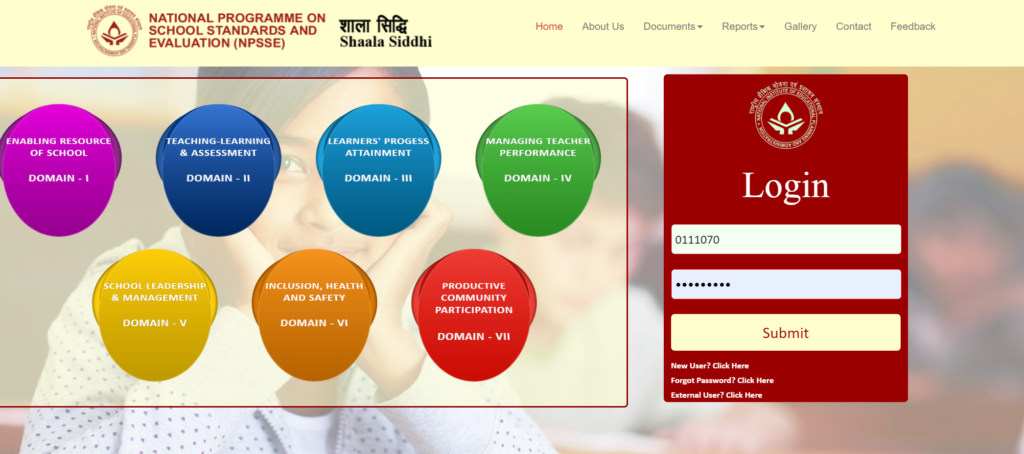Table of Contents
ToggleIntroduction to Dysgraphia: Teaching Strategies-Module 13

Teaching strategies for dysgraphia, a learning disorder that affects writing ability and fine motor skills, should be tailored to the individual’s specific challenges and strengths. Here are some effective approaches:
Use of Assistive Technology: Introduce assistive technology tools such as speech-to-text software, word prediction programs, or specialized keyboards to help students overcome writing difficulties. These tools can reduce the physical demands of writing and allow students to focus more on expressing their ideas.
Handwriting Instruction: Provide explicit instruction in handwriting skills using a multisensory approach. Focus on proper letter formation, spacing, and alignment. Use tactile materials like sandpaper letters or textured paper to reinforce letter shapes.
Modified Writing Tasks: Modify writing tasks to reduce the physical demands while still emphasizing the development of communication skills. For example, allow students to type assignments on a computer or use a scribe for extended writing tasks.
Pre-Writing Activities: Teach pre-writing strategies such as brainstorming, outlining, and graphic organizers to help students organize their thoughts before writing. Encourage them to use visual aids, verbal prompts, or assistive technology to plan their writing.
Explicit Instruction in Grammar and Spelling: Provide explicit instruction in grammar, punctuation, and spelling to help students develop written language skills. Break down complex rules into smaller, more manageable chunks and provide plenty of practice and reinforcement.
Provide Alternative Writing Tools: Offer alternative writing tools such as pencils grips, adapted writing utensils, or specialized paper with raised lines to support students with fine motor difficulties. Experiment with different tools to find what works best for each student.
Encourage Typing Skills: Encourage the development of typing skills as an alternative to handwriting. Typing may be easier and less physically taxing for students with dysgraphia, allowing them to express their ideas more fluently.
Chunking Writing Tasks: Break writing tasks into smaller, more manageable chunks to reduce cognitive overload and frustration. Focus on completing one section at a time and provide frequent breaks as needed.
Provide Feedback and Support: Offer constructive feedback and support to help students improve their writing skills. Focus on strengths and provide specific suggestions for areas needing improvement. Encourage students to revise and edit their work with guidance.
Build Confidence and Motivation: Celebrate successes and build confidence by acknowledging progress and effort. Create a supportive and encouraging learning environment where students feel safe to take risks and explore their writing abilities.

Dysgraphia: Teaching Strategies-Module 13
Dysgraphia: Teaching Strategies-Module 13 Answer key
1. What are the signs and symptoms of children with dysgraphia?
– Confusion between uppercase and lowercase alphabets
– Poor written organization on the page
– Cramped fingers while holding the pen or the pencil
– All of the above
– Answer: All of the above
– Explanation: All of the options listed are signs and symptoms commonly associated with dysgraphia.
2. Dysgraphia is a neurodevelopmental disorder which manifests as illegible handwriting due to the difficulty in letter formation.
– True
– False
– Answer: True
– Explanation: True. Dysgraphia is indeed a neurodevelopmental disorder characterized by difficulty in handwriting, including letter formation.
3. Students with Dysgraphia are unable to form the shape of the letter, meaning their brain cannot understand the shape of the letter.
– True
– False
– Answer: False
– Explanation: False. While individuals with dysgraphia may have difficulty in forming letters, it is not accurate to say that their brain cannot understand the shape of the letter.
4. Dysgraphia is a disorder which is related to difficulty in storing and retrieving orthographic codes or the letter forms.
– True
– False
– Answer: True
– Explanation: True. Dysgraphia is indeed related to difficulty in storing and retrieving orthographic codes or the letter forms, making writing challenging for individuals with this disorder.
5. Providing additional coaching to a child with dysgraphia, to help him improve writing expression and his writing skills is commonly known as:
– Remedial Teaching
– Accommodation
– Modification
– Tuition
– Answer: Remedial Teaching
– Explanation: Remedial teaching involves providing additional coaching and support to help a child improve specific skills or overcome learning difficulties.
Dysgraphia: Teaching Strategies-Module 13 Answer key
6. Finger painting, or writing in clay or sand tray helps the students to practice writing movements.
– True
– False
– Answer: True
– Explanation: True. Finger painting, writing in clay, or using a sand tray can help students practice writing movements and develop fine motor skills.
7. Accurate sitting position of the student while writing is not important to enhance their writing skills.
– True
– False
– Answer: False
– Explanation: False. Accurate sitting position is important for writing skills as it can affect posture, hand stability, and overall handwriting quality.
8. Usage of stencils or templates to draw numbers, alphabets, or pictures, does strengthen the finger grip and coordination.
– True
– False
– Answer: True
– Explanation: True. Using stencils or templates can help strengthen finger grip and coordination by providing structured practice for fine motor skills.
9. It is a good strategy to ask students to use paper with wide lines to help them determine the placement of letters.
– True
– False
– Answer: True
– Explanation: True. Using paper with wide lines can help students with dysgraphia better determine the placement of letters and improve handwriting legibility.
10. A dot-dot practice activity will improve the students’ perception of visual closure as well as their accuracy in formation of the letters.
– True
– False
– Answer: True
– Explanation: True. Dot-dot practice activities can improve students’ perception of visual closure and help them develop accuracy in forming letters.
Dysgraphia: Teaching Strategies-Module 13 Answer key
11. Sometimes students tend to forget the direction of the letters, which is why it is better to give them verbal cues while writing.
– True
– False
– Answer: True
– Explanation: True. Providing verbal cues can help students remember the direction of letters while writing and improve overall letter formation.
12. A prerequisite of acquiring good writing skill is to strengthen alphabet and number writing through the Tracing Method.
– True
– False
– Answer: True
– Explanation: True. Tracing letters and numbers can help students develop the motor skills necessary for good writing.
13. Sensory input does not enhance the learning and retention of a child with dysgraphia.
– True
– False
– Answer: False
– Explanation: False. Sensory input, such as finger painting or writing in clay, can enhance learning and retention for children with dysgraphia by providing multisensory experiences.
14. Instructional adaptation means adapting ways of teaching the students as per his or her individual level of intelligence.
– True
– False
– Answer: True
– Explanation: True. Instructional adaptation involves adapting teaching methods to suit the individual needs and abilities of students, including their level of intelligence.
15. Verbal pathways which are basically visual and verbal cues help students to improve their pre-writing skills.
– True
– False
– Answer: True
– Explanation: True.


